

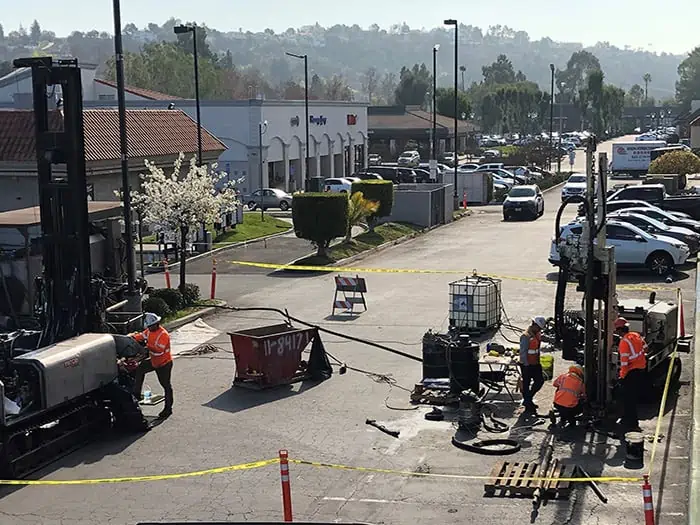
Introduction
Contamination at thousands of shopping centers across California from previous business operations presents problems for property owners who wish to continue commercial use, redevelop, and maintain property value. Commercial property remediation targets returning these buildings and land to predevelopment conditions, presenting opportunities for reuse and redevelopment.
One property owner discovered that securing adequate funding and working closely with state and regional regulatory agencies leads to success despite changing regulations and oversimplifying regulatory health risk assessment methods. The Draft Cal-EPA Supplemental Vapor Intrusion Guidance (DSVIG) suggests changes to the methods in which vapor phase transport and potential health risks are modeled and calculated for occupants of buildings with known soil or groundwater contamination beneath them. These changes, the result of a multi-year working group collaboration, recommend an arguably more conservative calculation of indoor air quality. The changes rely on EPA work and guidance, with empirically derived attenuation factors (AFs), which will increase the number of sites requiring additional environmental assessment and mitigation to achieve health risk standards. Although the DSVIG is currently draft guidance, there is evidence that regional regulatory agencies have already adopted AFs in calculating indoor air quality.
Diamond Bar Commercial Center Assessment and Mitigation
Drucker Survivors Trust owns and operates a multi-tenant commercial building in Diamond Bar, California, including a dry cleaner at one time. The former cleaners caused an unauthorized release of dry cleaning solvent containing chlorinated volatile organic compounds to the subsurface during its operation.
Financing for this all too common situation requires environmental due diligence in the form of research commonly completed in a Phase I Environmental Site Assessment followed by an assessment to characterize potential liabilities associated with chlorinated solvent releases before lenders provide funding.
Regulatory oversight in California can either be voluntarily engaged or involuntarily if assessment activities on an adjacent or nearby property indicate the presence of chlorinated volatile organic compounds in the subsurface linked to dry cleaning operations in the vicinity.
The Drucker Survivors Trust sought approval from the applicable regulatory agency, Los Angeles Regional Water Quality Control Board (LARWQCB), to assess and mitigate the chlorinated solvent release to ensure the protection of human health and reduce environmental liabilities associated with the property.
Regulatory closure is the acceptance of assessment and remediation activities by the governing regulatory entity to bring the site into compliance. Compliance, in this case, required assessment and mitigation of beneficial use groundwater underlying the property impacted by the solvent release and completing soil vapor assessment and health risk screening calculations under current state and federal guidelines.
Guidance on vapor assessment and associated health risk screening methods have changed rapidly in California state environmental regulations. As environmental engineers and consultants, SCS professionals manage an extensive list of vapor assessment, health risk assessment, and vapor intrusion mitigation projects resolving these vapor–related issues.
To start this project, the SCS team prepared a successful grant application securing more than $650,000 in funding from the California State Water Resources Control Board’s Site Cleanup Subaccount Program (SB 445, established in 2014). This state-provided grant money enables the assessment and mitigation necessary to close with the LARWQCB.
Subsurface assessment activities defined the extent and scale of chlorinated solvent impacts to soil vapor, soil, and groundwater, enabling the design of a remediation program. To reduce the groundwater contamination to cleanup levels set by the LARWQCB, SCS Engineers designed and implemented an injection program to deliver engineered chemicals directly to the groundwater plume. The injected chemicals destroy the chlorinated solvents via in situ chemical reduction and stimulation of biological degradation.
While challenging drilling conditions precluded previous consultants from attempting groundwater remediation, SCS industry experts safely achieved up to a 99 percent concentration reduction within the groundwater plume. SCS designed a soil vapor assessment that relied more on site-specific data collection and less on conservative default assumptions while conforming to the most current regulatory guidance targeted at minimal impact on the building tenants.
SCS managed all aspects of the project, including grant requirements and communication between the client, regional and state water board staff, city staff, and subcontractors. Obtaining and managing entrance under state waste discharge requirements is necessary, and SCS completed all necessary permitting and reporting requirements to facilitate the groundwater mitigation activities. Careful planning and experience with similar projects minimized impacts on tenants and kept the project on a strict timeline with no missed regulatory deadlines. SCS continues working with the LARWQCB to conclude the client’s final closure requirements and is in the process of applying for an additional $900,000 in SCAP funding to implement the final stages of the project targeted at obtaining final regulatory closure.
Changes Coming to Regulatory Guidance
Recent changes to regulatory guidance in California are arguably making obtaining closure on sites with vapor intrusion health risk concerns more difficult to achieve. The Draft Cal-EPA Supplemental Vapor Intrusion Guidance (DSVIG) suggests changes to the methods in which vapor phase transport and potential health risks are modeled and calculated for occupants of buildings with known soil or groundwater contamination beneath them. These changes, which result from a multi-year working group collaboration, recommend a more extensive and site-specific data collection effort. They include indoor air quality calculation methods relying on EPA work and guidance and empirically derived attenuation factors (AFs) which some would argue lead to overestimating potential health risks.
The consequences of the DSVIG are potentially significant if adopted as is and appear likely to result in more sites being “screened in” with vapor intrusion issues and more sites requiring mitigation. The impact, resultant costs, and possibly detrimental secondary effects such as decreases in affordable housing production, particularly in urban infill areas. And while none would argue with appropriate protection of health risk, the question is whether the studies and empirical data used to support the DSVIG represents the best available science and is truly representative and predictive of risk.
The DSVIG adopts an attenuation rate of 0.03 for the flux of both soil and sub-slab vapor to indoor air based on a previous 2012 EPA Study comprised of empirical data collected from buildings arguably not representative of modern construction in California.
The development of a reliable screening level attenuation factor for California based on high-quality, recent, California-specific data:
1) Will be protective of human health, as no toxicological imperative or basis supports a call for accelerated or immediate action (as evidenced by the fact that the DSVIG workgroup commenced its work in 2014 and issued the review draft in 2020).
2) Will ensure California’s environmental policy satisfies the gold standard for data quality and insightful analysis in which the state once took pride.
3) Will not unnecessarily decimate the California housing development market. The empirically derived screening level AF in the DSVIG is overly conservative based on the available data. More accurate empirical data and measurement methods for site-specific measurement are available.
With respect, oversimplifying the VI health risk assessment methods has constrained the environmental community’s ability to apply science-based health risk screenings, often resulting in costs associated with additional environmental assessment and mitigation. An additional revision to the DSVIG to utilize a screening level AF more reflective of the current California data and building specifications could save state resources, increase infill development by reducing urban sprawl, promote housing development, all while protecting human health.
About the Author: Keith Etchells is a professional geologist and hydrogeologist with over two decades of experience assisting clients in managing environmental risks associated with ownership, transfer, or operation of commercial, industrial, and waste disposal properties. His particular technical expertise involves aspects of groundwater science and engineering relevant to contaminated sites and landfills, including supervision and conduct of subsurface data acquisition, remedial design and implementation, conceptual site model development, aquifer testing, extraction well design, groundwater quality evaluation and treatment, vapor intrusion health risk assessment and mitigation, predictive modeling, and contaminated soil and groundwater remediation design.
He is responsible for designing analytical, geotechnical, and hydrogeological data collection programs to complete subsurface assessment and remediation. He has prepared subsurface assessment documents, property mitigation plans, vapor intrusion risk assessment documents, soil management plans, aquifer characterization documents, conceptual site models, and groundwater remedial design and implementation documents.
Application Process for $275M in California Grants Opened Jan. 31
A couple of months ago, I wrote about the opportunities and challenges of getting brownfields back into productive use. There are certainly viable strategies for remediation of contaminated property that will make them safe for a range of developments. Of course, the cleanup costs are a significant factor in any project analysis. But the state of California is providing some assistance that could make more brownfield sites pencil out for redevelopment.
I am happy to report in this article that the passage of SB 158 by the California legislature provides $500 million in cleanup funding for brownfields. Approximately $270 million of that total is targeted for grants.
The California Department of Toxic Substance Control (DTSC) administers the Equitable Community Revitalization Grants funded through SB 158. On January 31 of this year, the DTSC started accepting full applications for these grants. The application window closes on April 4, 2022, with award announcements expected on May 31, 2022.
The DTSC gives the highest priority for grants in disadvantaged communities with significant housing needs.
$270 million is a big investment. The USEPA has a similar program, with typical funding for the entire country, of less than $100 million (https://www.epa.gov/newsreleases/epa-announces-selection-151-communities-receive-665-million-brownfields-assessment-and). Since DTSC started accepting applications at the end of January, nonprofits, public agencies, municipalities, tribes, and private developers must act quickly.
Eligible entities may apply for ECRG grants for properties they own or control in high poverty areas with a CalEnviroScreen score of 75 percent or more for reuse. DTSC will also accept applications outside of the CalEnviroScreen score of 75%+ if the proposed reuse provides significant community benefit.
As I outlined in my previous article, it is important to have a risk management strategy that includes a thorough understanding of the environmental issues on the site and how those issues can impact your redevelopment plans and bottom line. Environmental and legal support experienced in identifying, anticipating, and managing risks on brownfields is critical to success.
There are an estimated 200,000 brownfields currently identified in California, many of which are useful for housing after remediation. Many of these sites are in the urban core and perfectly fit infill strategies for solving the housing crisis by reducing commute times and related greenhouse gases.
An example of such a project is COMM22 in San Diego, developed by BRIDGE Housing, in which SCS provided environmental oversight during remediation. COMM22 is a mixed-use, mixed-income, transit-oriented development located at Commercial and 22nd streets in San Diego.
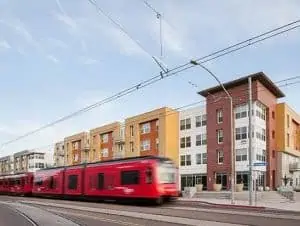
The site where COMM22 stands today was a former San Diego Unified School District vehicle maintenance and general maintenance facility. The site included leaking underground storage tanks and fill soils containing various metals, including lead.
After successful remediation, the parcel today hosts 211 affordable housing units, including apartments for low-income seniors (including HUD-subsidized units), supportive housing for youth transitioning out of the foster care system, and eleven townhomes for low- and moderate-income families.
Many more badly needed projects, like COMM22, could become a reality thanks to SB 158. If you have a brownfield in mind that fits the criteria or have questions about the grant application process, contact the Center for Creative Land Reuse (www.cclr.org). CCLR partners with the DTSC to give free assistance in applying for funding.

Learn more about funding and land remediation here.
Recent changes to regulatory guidance in California are arguably making obtaining closure on sites with vapor intrusion health risk concerns more difficult to achieve. The Draft Cal-EPA Supplemental Vapor Intrusion Guidance (DSVIG) suggests changes to the methods in which vapor phase transport and potential health risks are modeled and calculated for occupants of buildings with known soil or groundwater contamination beneath them. These changes, which result from a multi-year working group collaboration, recommend a more extensive and site-specific data collection effort. They include indoor air quality calculation methods relying on EPA work and guidance and empirically derived attenuation factors (AFs) which some would argue lead to overestimating potential health risks.
The consequences of the DSVIG are potentially significant if adopted as is and appear likely to result in more sites being “screened in” with vapor intrusion issues and more sites requiring mitigation. The impact, resultant costs, and possibly detrimental secondary effects include decreases in affordable housing production, particularly in urban infill areas. And while none would argue with appropriate protection of health risk, the question is whether the studies and empirical data used to support the DSVIG represents the best available science and is truly representative and predictive of risk.
The DSVIG adopts an attenuation rate of 0.03 for the flux of both soil and sub-slab vapor to indoor air based on a previous 2012 EPA Study comprised of empirical data collected from buildings arguably not representative of modern construction in California. The development of a reliable screening level attenuation factor for California based on high-quality, recent, California-specific data:
1) Will be protective of human health, as no toxicological imperative or basis supports a call for accelerated or immediate action (as evidenced by the fact that the DSVIG workgroup commenced its work in 2014 and issued the review draft in 2020).
2) Will ensure California’s environmental policy satisfies the gold standard for data quality and insightful analysis in which the state once took pride.
3) Will not unnecessarily decimate the California housing development market. The empirically derived screening level AF in the DSVIG is overly conservative based on the available data. More accurate empirical data and measurement methods for site-specific measurement are available.
Oversimplifying the VI health risk assessment methods has constrained the environmental community’s ability to apply science-based health risk screenings, often resulting in costs associated with additional environmental assessment and mitigation. An additional revision to the DSVIG to utilize a screening level AF more reflective of the current California data and building specifications could save state resources, increase infill development by reducing urban sprawl, promote housing development, all while protecting human health.
Take a deeper dive into this topic in the Daily Transcript article Vapor intrusion rules hamper infill projects.
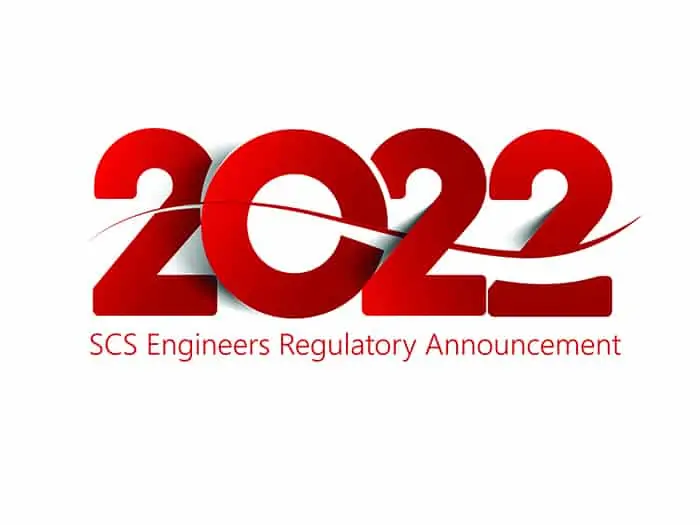
The Department of Toxic Substances Control’s Office of Brownfields’ Equitable Communities Revitalization Grant (ECRG) provides funds to incentivize cleanup and investment in disadvantaged areas of California. ECRG is setting a new path for land use that will have immediate and lasting benefits for communities, parks and green spaces, commercial enterprises, and housing.
Apply for grant funding to help Californian government units, nonprofit organizations, and Tribes assess, clean up and reuse idled and contaminated properties in the state’s environmental justice communities.
The application deadline is April 4, 2022.
Don’t miss this unique opportunity for grant assistance to clean up and revitalize our communities.
“The Infrastructure Investment and Jobs Act, signed into law last month, will dedicate more than $1.5 billion to the U.S. EPA Brownfields program. The Act includes hundreds of millions of dollars allocated to Multipurpose Grants, Assessment Grants, Cleanup Grants, Revolving Loan Fund Grants, and technical assistance intended to improve equity, create jobs, and mitigate environmental degradation.”
CCLR has provided the expected breakdown and timelines from EPA. The EPA has hundreds of millions of dollars allocated for FY22 that will be applied for in July and awarded in November 2022. This timeline is different and with much larger individual grants possible, up to $10mil per grant.
SCS Engineers has a stellar win rate for brownfields grant writing and implementing brownfields programs. Please let our brownfields and remediation experts know if you have any questions or if we can provide assistance in grant support.
Click here to learn more and obtain support and funding for your community’s brownfields project.
Progressive energy companies are rushing to corner the growing hydrogen market, excited as they see this renewable fuel’s cost steadily drop and as they prioritize decarbonization.
As they work to stay ahead of the pack, they need to put time and thought into building out and implementing these projects. There are complex technical and regulatory considerations; safety is also priority one at every step when managing this flammable, compressed gas.
As the market takes off, there is a need for scaled development along the whole supply chain, and some developers are rising to the occasion for more control and more opportunity. Rather than only build fueling stations, they buy into vertically integrated hydrogen networks to produce, transport and distribute hydrogen. But these multifaceted projects present even more complexity— calling for a team with highly specialized, comprehensive skill sets.
SCS Engineers supports energy companies and contractors looking to diversify their hydrogen services portfolio to include building production plants, including moving the gas via pipeline or truck to offload at fueling stations, ultimately selling to consumers.
“We enter these strategic partnerships to give our clients what they are looking for: a full spectrum of competencies and services; and a proven history of working on hydrogen to deliver turnkey projects. The idea is to take the environmental burden off clients as they pursue these major undertakings,” says Nathan Eady, an SCS vice president, and project manager.
SCS makes site selection; performs environmental due diligence and remediation; feasibility analysis; design and construction of environmental controls; land use, air, and water quality permitting.
The contractors’ specializations are detailed design, engineering, and construction management–from civil to structural to mechanical and fire protection.
This team meets all environmental and regulatory design requirements and develops process safety management and risk management plans with their combined expertise. They also take on the role of community educator, explaining the unique attributes of hydrogen and easing any concerns.
“We take science and engineering and translate that for neighbors and city councils. It’s important to show communities, as well as regulators, that these facilities are designed and operated with the utmost safety,” Eady says.
Requirements vary from jurisdiction to jurisdiction. But with a national reach, SCS sails through processes and regulations by region.
“That matters to our clients; they want to get through the detailed permitting steps and launch as soon as they can to maintain their competitive edge. And when they plan to expand into other regions, they like to know they already have a vetted team in place who knows the territory and can do the work there,” he says.
Permitting and technical considerations vary by location and production method, whether via steam methane reforming (SMR) or electrolysis.
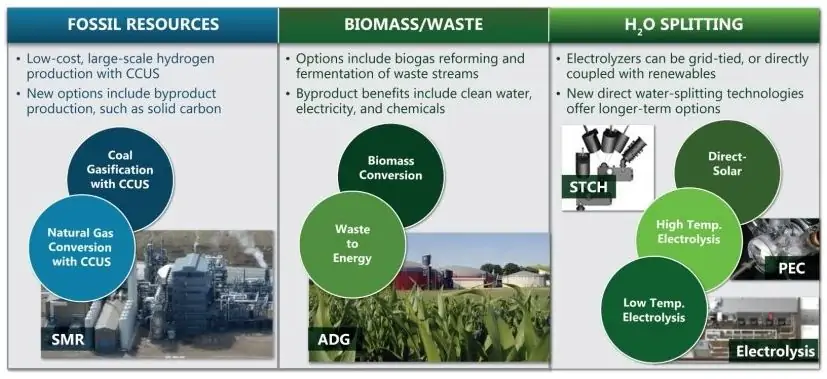
Some operators are taken off-guard by the air quality permitting requirements associated with SMR facilities − or the stringent wildlife and water quality regulations encountered with the larger footprint photovoltaic systems requiring open space to support electrolysis. SCS has the expertise to address the issues, whether state-specific cap and trade regulations for carbon emissions or air basin specific criteria pollutants. SCS also has the unique talent of finding brownfield sites or closed landfill properties, making excellent receiver sites for electrolysis and solar facilities near existing infrastructure.
Building hydrogen projects on these idle properties can save developers significant time and money in the overall project outcome.
“We do a lot of brownfield work helping to clean and redevelop these properties. These sites have special permitting considerations, especially since they typically have a history of industrial use,” Eady says.
SCS performs Phase I Assessments to research records on previous use, and if the team finds a potential problem, they move to Phase II, which entails groundwater and soil testing.
“If we find evidence of existing contamination, we reconcile it so our clients can move forward with the development of their new facilities,” Eady says.
SCS is seeing a growing interest in building hydrogen projects on closed landfills. As brownfields, they have value for their open space and often have some existing infrastructure, offsetting the cost of building new.
“We have done permitting and design work on several closed landfills, sometimes adding solar systems. Hydrogen projects leveraging electrolysis require a tremendous amount of electricity, and when we can bypass the grid enabling clients to make their own electricity, it’s a major plus,” Eady says.
Lately, large energy companies are pivoting from conventional oil and gas to hydrogen, and some smaller, young companies are also joining the clean renewables movement.
SCS has gotten interest from startups looking to obtain government grants and subsidies. Some of these firms need more process engineering support to ensure their new technology can operate at a cost and environmental efficacy equivalent to larger operations.
“We use our knowledge gained working with major conventional energy companies to support these new hydrogen firms in executing successful launches. All in all, a positive trend.”
Together, SCS and its partners play an integral role in helping to see hydrogen continue to climb the energy sector ranks, maintaining an excellent record of accomplishment supporting the planning-design-build of clean-energy plants.
Additional Resources
Popular Mechanics recently published an article entitled The Pungent History of America’s Garbage Mountains. The article starts with a little-known ferryman on Lake Michigan when a storm beached his craft on an offshore sandbar in July 1886. Thus started Chicago’s open dump on today’s Lake Shore Drive, home to landmarks such as the Museum of Contemporary Art, the Wrigley Building, the Chicago Tribune Tower, Northwestern University, and the Magnificent Mile – all on turn-of-the-century garbage.
Transportation centers, stadiums, and even entire neighborhoods are now built on landfills. This is a fascinating, well-written article on the history and possibilities of building on remediated properties and brownfields.
“Landfill redevelopment projects tend to be real estate projects, and you know what matters in real estate: location, location, location,” says Mike McLaughlin of SCS Engineers, who specializes in brownfields and landfill redevelopment. “A landfill in an urban area might be the only piece of open land in that area. People go to extraordinary lengths to redevelop because the property is so valuable.”
Michael W. (Mike) McLaughlin has been elected to the Virginia State Bar Environmental Law Section Board of Governors. His four-year term began on July 1. Mike began his career with SCS as a summer intern as a rising sophomore at Virginia Tech. After receiving his civil (environmental) engineering degree, he received his J.D. from Washington & Lee University School of law. He has been with SCS ever since, applying his combination of law, science, and engineering expertise to environmental matters. His knowledge helps businesses and communities protect air, water, and land resources while serving the needs of their clients or constituents.
McLaughlin recalls his early career choices: “It was exciting to work on some of the earliest research projects sponsored by the then-new Environmental Protection Agency. I chose W&L Law because it had Professor Andrew (Uncas) McThenia on its faculty. Uncas was a Virginia State Water Control Board member and taught one of the few environmental law classes in the country. When I told him he was the reason I came to W&L, Uncas apologized and said he would not teach environmental law anymore—the field had too much politics involved. That was an early and important lesson for me.
“Not to worry,” says Mike. “Turner Smith of the Hunton & Williams law firm taught the environmental law class; he was one of the country’s most well-known Clean Air Act attorneys. His knowledge of the subject matter and teaching ability inspired several of us to seek careers in the field.”
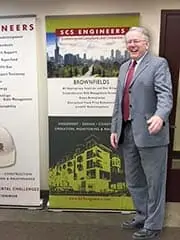
Mike is SCS Engineers’ Senior Vice President of Environmental Services. He advises developers, contractors, lenders, and land development professionals on the technical and regulatory requirements for construction on brownfield sites nationwide. Landfill redevelopment is an area of special interest. His combined engineering and legal background provides an unusual perspective on land development where hazardous wastes or other environmental challenges are present.
In addition to his extensive brownfield redevelopment experience in North America, Mike has worked at more than three dozen Superfund National Priorities List sites in 17 states and on scores of regulatory compliance, voluntary cleanup, and remediation projects for commercial, industrial, municipal, and military clients. His work for electric utilities began in 1980 with research on upgrading solid waste management and has evolved to support greenhouse gas mitigation measures and support the transition to renewable energy.
Mike’s new role with the VSB builds on his decades of experience with the American Bar Association Section of Environment, Energy, and Resources, where he is completing a two-year term as Budget Officer and a member of the Executive Committee.
The American Rescue Plan Act of 2021 was signed into law on March 11, 2021. It provides funds to address health outcome disparities from pollution and the COVID–19 pandemic.
EPA is assisting under-resourced communities by quickly getting out ARP funding to leverage important programs that improve air quality, drinking water, revitalization of brownfields, diesel emissions from buses in low-income communities and communities of color. In addition, the agency is awarding its first competitive grants focusing directly on the unequal impacts the COVID-19 pandemic has had on communities of color, low-income communities, and other vulnerable populations.
Projects include training, developing citizen-science tools, pollution monitoring, and educational campaigns to enable EJ advocates such as SCS Engineers, scientists, and decision-makers to address pollution and create thriving communities.
Funding currently being distributed totals approximately $2.8 million for 14 EJ-focused projects, with more to be announced soon throughout the country. In addition to the Baltimore City grant, today’s announcement includes funding for the following projects in underserved communities:
EPA also announced for the first time how the agency would distribute the $50 million in ARP funds.
A breakdown is provided below:
The main thoroughfare in Madison, Wisconsin, leading to the state capitol, is going through a major renaissance. Once an idle brownfield, and before that an active industrial-commercial area, the entire block has now been converted to residential, commercial, and office spaces, as well as a youth art center. After extensive due diligence to assess, then successfully remediate significant adverse environmental conditions from past uses, the property’s new mixed-use buildings are open for occupancy. The community art center opens in 2021.
The block formerly housed a dairy operation, gas station, auto maintenance shops, a print shop, and a dry cleaner. These past uses and the historic fill placed on the property resulted in chlorinated solvents, petroleum, polycyclic aromatic hydrocarbons (PAHs), and heavy metal contamination.
Remediating and mitigating environmental contamination and redeveloping brownfields like this one into vibrant, revenue-generating community assets takes pooled expertise from multiple disciplines, including hydrogeology and environmental engineering.
While these projects can provide high value for communities long into the future, they are complex and require large investments up front, explains Ray Tierney, an SCS vice president. Having a team that gets a full picture of the property’s environmental condition, knows regulators’ expectations, and can identify technically sound, cost-effective remediation and mitigation approaches can translate to substantial money savings.
In this case, a solid knowledge base and vetting key details resulted in seven-digit figure savings and facilitated prized redevelopments.
“We identified the amount of soil and groundwater contamination, evaluated strategies to best address the issues, and came up with a cost estimate for remediation. Based on the estimate, along with documentation validating the scientific rationale for our recommendations, the seller reduced their price to account for the legacy environmental liabilities which the purchaser agreed to accept and address as part of the property’s redevelopment.”
SCS Engineers assessed for contamination; oversaw the management of contaminated soil and groundwater during construction according to the materials management plan; supported the client in securing grants, permits and documented compliance with the approved planning documents.
For this project, as is often true in historic urban areas, the greatest expense was dealing with widespread contamination found in the historic fill soils and with groundwater issues.
“Our client is obligated to handle contaminated materials properly. We plan and permit the proper procedures, work with contractors to facilitate the work, documenting that procedures and plans are followed while making sure they only invest what is necessary to be judicious in protecting the environment and public health,” says the SCS Project Manager and Geologist Dr. Betty Socha.
During construction, Socha’s team was onsite to assist contractors in complying with environmental plans and permits, documenting that activities were completed safely and in compliance with Wisconsin Department of Natural Resources (WDNR) expectations. The team oversaw soil removal and management during site demolition and construction of the foundation, including piles and a structural slab. This support system reduces the geotechnical requirement of the underlying soils to reuse more onsite soil safely. But knowing what soil is acceptable and orchestrating the separation of contaminated and non-contaminated materials takes specialized expertise and skill.
“During construction, we evaluate soil conditions, so contaminated soil is safely disposed of at a landfill. But landfilling large volumes of soil is a considerable expense, so it’s important to determine what is safe to be segregated as clean soils for reuse elsewhere. Knowing how to do this efficiently will minimize disposal costs and maximize the use of valued resources,” Socha says.
Getting a handle on groundwater conditions and identifying the best management strategy requires equal attention.
“This property sits on a strip of land (an Isthmus) between two large and prized lakes, with a shallow water table. We thoroughly assessed the groundwater (aka, hydrogeologic) site conditions and managed groundwater generated during construction and dewatering activities,” says Tierney.
“We documented the extent of contamination, and the WDNR confirmed our evaluation that no additional remedial groundwater treatment systems were needed. We could show the contamination was contained enough to pose no risk to municipal wells, private wells, surface water, or other sensitive environments. However, the client still needed a permit to dispose of the contaminated groundwater generated during dewatering for construction of the building foundation and underground utilities,” says Tierney.
Major brownfield redevelopment projects are involved with multistep processes. They begin with a Phase I Environmental Assessment entailing an inspection of the property and a historical review.
That’s where SCS initially identifies potential or existing environmental liabilities from contamination. Then the team confirms the presence of multiple soil and groundwater contaminants through a Phase II Assessment, involving collecting and analyzing soil and groundwater samples.
Next comes a site investigation, a robust testing program to see exactly what is going on. This is where the team further defines contamination, locations, how far it spread, and concentrations. That information lays the groundwork for developing the remedial action plan to file with the WDNR. The team then works with the redevelopment contractors to seamlessly and concurrently manage both the property’s remediation and the buildings’ construction.
In Madison, Socha, Tierney, and their team also helped the developer apply for and win a $500,000 brownfield grant from the Wisconsin Economic Development Corporation, a practice that is as much an art as a science. Additional public support for the project was also received through tax incremental financing (TIF) and the Wisconsin Housing and Economic Development Authority (WHEDA) tax credits for low‐income housing.
“We merge our technical backgrounds to show the land has the potential to be turned into a strong asset that addresses the legacy environmental contamination, promotes public health, and delivers a high-value property that pays taxes and supports important city services,” says Tierney.
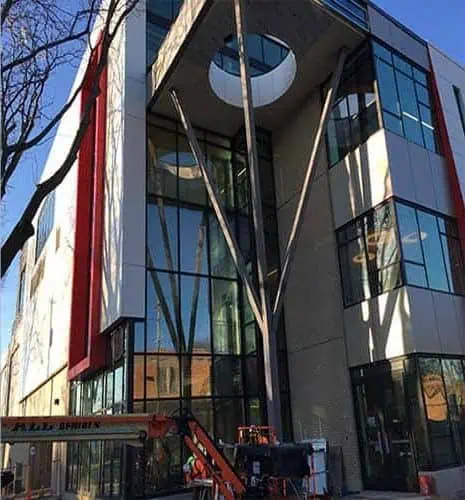
It takes technical horsepower to show regulators just how you are addressing contamination. You need to show the economic development group awarding the grant that the project will create well-paid jobs and tax revenue. Equally important, it must be shown that the redevelopment helps address a community need for affordable workforce housing and additional market-based housing,” Tierney says.
Tenants have already moved into the two 11-story mixed-use buildings. In addition, The Madison Youth Arts Center (MYAC) is slated to open in early summer, with a grand opening ceremony this fall. The MYAC includes classrooms, offices, rehearsal spaces, and a 300-seat auditorium.
The final project showcases the heartbeat of this popular downtown space situated between two large lakes, with features such as a rooftop terrace, plazas with seating and green space, and soon to come are 3D urban art installations and murals that tell the story of this long-lived community.
“The redevelopment of brownfields and the creation of projects like the Lyric and the Arden align with the City of Madison’s Performance Excellence Framework Vision of Our Madison – Inclusive, Innovate, and Thriving. These types of redevelopment projects help the City act as a responsible steward of our natural, economic, and fiscal resources. While making efficient use of land and cleaning up brownfields, the City is able to provide workforce housing, job opportunities, and cultural venues, all while enhancing the City’s tax base,” says Dan Rolfs, the Community Development Project Manager for the City of Madison’s Office of Real Estate Services – Economic Development Division.
It takes a village, or in this case – a City, to revitalize an urban brownfield!
Brownfields Resources to Organize, Educate, and Implement Plans in Your Community